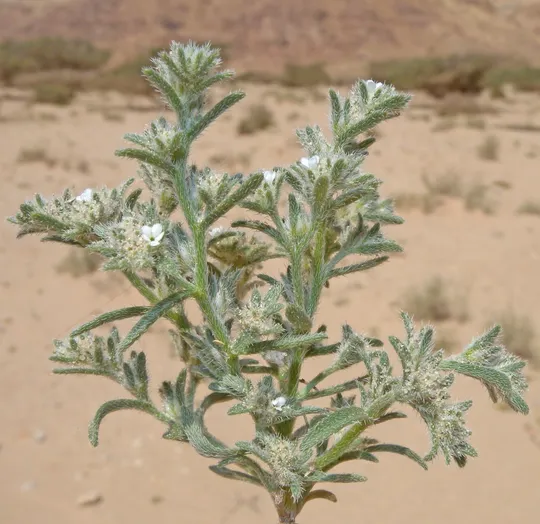Heterocaryum subsessile






Heterocaryum subsessile
grows in the northern and southern Negev and was collected and observed at a
total of five sites. It was collected in the northern Negev once in 1967 from a
wadi in the Hatrurim area east of the Arad Mountains (Avinoam Danin). Mimi Ron observed
the species in the southern Negev in 1998 on Mount Gabriel and Mount Karkom by,
and in the spring of 2010 (an exceptionally rainy year in the Negev) in upper Wadi
Arod and on the northern slope of Mount Sagi. Although the species is typical
of the high desert mountains it has never been observed yet in the Negev
Highlands.
In Israel on rocky
limestone slopes in Desert Mountains and wadis at altitudes above 600 m. The specimens
in Edom were observed on rocky limestone slopes and at the edges of an irrigated
olive grove at an altitudes above 1350 m together with Artemisia sieberi
and Astragalus bethlehemiticus.
Heterocaryum
is a small genus in the Boraginaceae family with six
species found from the Middle East to Central Asia. This genus belongs to a
large group of Arava desert genera in the Boraginaceae family, such as
Lappula
and Paracaryum, whose fruit mericarps are well developed and dispersed
over long distances either by wind or by animals (Shmida, 1978). This differs
from other genera in the Boraginaceae family, e.g. Myosotis and Buglossoides, found
mainly in northern Europe, whose mericarps are small and lack additions that facilitate
dispersal. All the Heterocaryum species are annuals. Some experts consider the genus a group
in the close genus Lappula, as was the case in the old Israeli plant identification
key (1984). The second species growing in the Negev, H. szovitsianum, is similar in its form to the Lappula
and Paracaryum annuals growing in the Negev. In the genus Paracaryum
each mericarp is equipped with a membranous vesicle-like crown that disperses
it in the wind. Almost always four mericarps develop, which separate from each
other as the fruit ripens. In Lappula the mericarps are equipped with sharp bristles
fringed with tiny hooked invisible protrusions that attach to the fur of animals
and are thus carried over great distances. In the European and northern Lappula species the ripe mericarps break
apart during dispersal, but in the desert and Mediterranean species they are dispersed
as a single unit that apparently disintegrates over the years. Heterocaryum is in an intermediate position
between Lappula and Paracaryum: each fruit has four mericarps arranged in a crossed pattern: two
mericarps equipped with bristles, similar to the Lappula fruit and two winged mericarps
similar to the Paracaryum fruit.
·
There are too
few Heterocaryum subsessile sites and
observations to enable assessment of long-term change trends.
·
The populations are
small and only individual specimens are usually observed in the field.
·
H. subsessile
sites are not easily accessible. There is a risk of local
extinctions due to the small number of plants in each population.
·
H. subsessile
is protected on Mount Sagi, Wadi Arod and Mount Karkom that are
located in the Negev Highlands Reserve.
·
It is common in
the Middle East and does not appear in other red species lists.
Field surveys
should be performed in the region of Arad and in areas to the south and the
southwest of Ramon Crater to locate undiscovered populations of Heterocaryum subsessile.
Existing and newly discovered populations should be surveyed annually to obtain an updated and more reliable status of the species in the
country. The establishment of new H. subsessile populations in the high Negev Highlands should be considered.
Heterocaryum subsessile is found in Israel,
southern Jordan (a-Shara ridge), the Syrian Desert, northern Iraq, and most
provinces in Iran. It has not been found so far in Sinai.
Heterocaryum subsessile is an extremely rare
small annual herb of the southern and northern Negev that has been observed
only a few times and whose number of sites is small. Efforts should be made to
locate new populations.
Shmida, A., 1978. Relationship between Paracaryum intermedium and P. boissieri in Sinai, and the generic separation of Parycaryum and Mattiastrum (Boraginaceae). Pl. Syst. Evol. 129: 323-326.
Current Occupancy Map
| 1000 squre meter pixel | 5000 squre meter pixel | 10000 squre meter pixel | |
|---|---|---|---|
| number of observations | 0 | 0 | 0 |
| in total pixels | 0 | 0 | 0 |
| Family | Boraginaceae |
| Classification | On the endangered species list |
| Ecosystem | Mountains in the Desert, Deserts |
| Chorotype | Irano-Turanian |
| Conservation Site | Upper Wadi Arod, Mount Sagi |
| Rarity |
1
5
6
|
|---|---|
| Vulnerability |
0
0
4
|
| Attractiveness |
0
0
4
|
| Endemism |
0
0
4
|
| Red number |
1
3.2
10
|
| Peripherality | E |
| IUCN category | DD EW EX LC CR EN VU NT |
| Threat Definition according to the red book | Vulnerable |
 Based on:
Based on:






